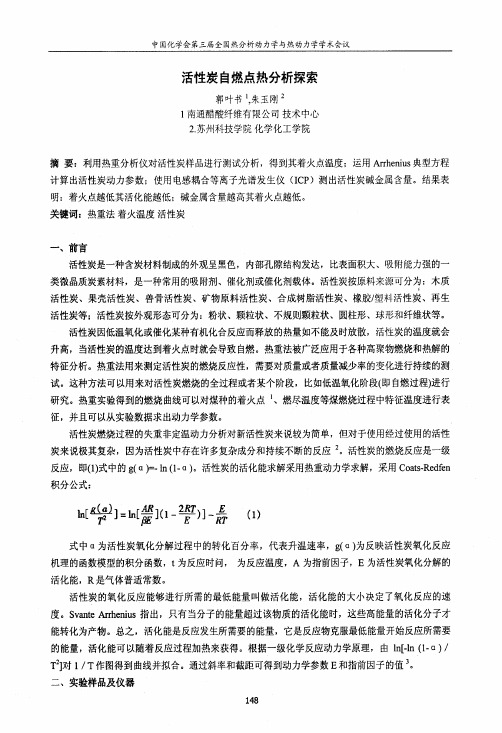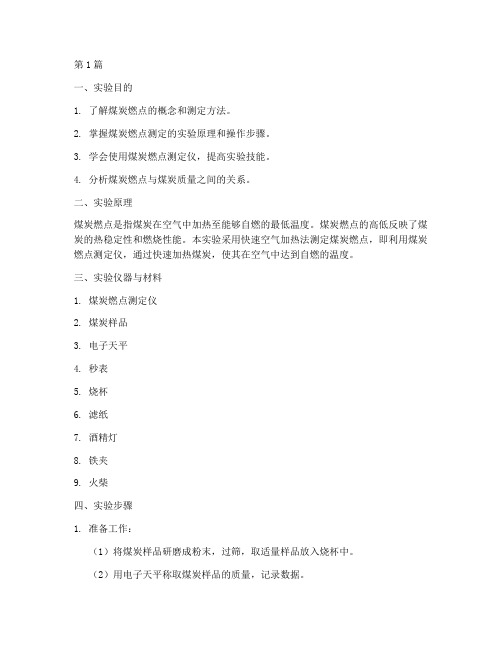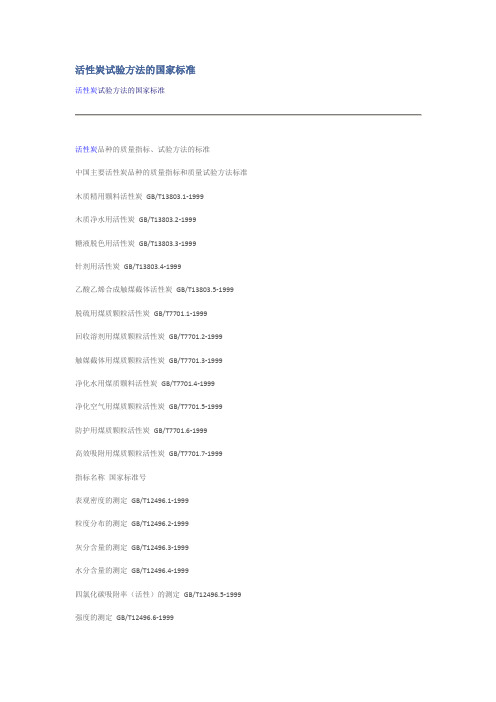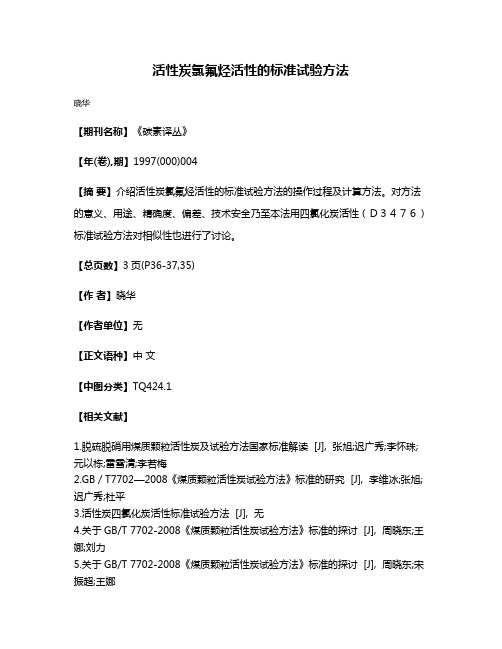D3466-76(1998)颗粒活性炭燃点的试验方法
活性炭自燃点热分析探索

(a-15#上层活性炭b-15#中层活性炭C-1 5#下层活性炭 d-17#上层活性炭e-17#中层活性炭B17#下层活性炭)
图3各活性炭样品Arrhenias及其拟台曲线
中国化学会第三届全国热分析动力学与热动力学学术会议
15#上层 活性炭
15#中层 活性炭
15#下层 活性炭
17#上层 活性炭
17#中层 活性炭
一、前言 活性炭是一种含炭材料制成的外观呈黑色,内部孔隙结构发达,比表面积大、吸附能力强的一
类微晶质炭素材料,是一种常用的吸附剂、催化剂或催化剂载体。活性炭按原料来源可分为:木质 活性炭、果壳活性炭、兽骨活性炭、矿物原料活性炭、合成树脂活性炭、橡胶/塑料活性炭、再生 活性炭等;活性炭按外观形态可分为:粉状、颗粒状、不规则颗粒状、圆柱形、球形和纤维状等。
式中Q为活性炭氧化分解过程中的转化百分率,代表升温速率,g(Q)为反映活性炭氧化反应 机理的函数模型的积分函数,t为反应时问, 为反应温度,A为指前因子,E为活性炭氧化分解的 活化能,R是气体普适常数。
活性炭的氧化反应能够进行所需的最低能量叫做活化能,活化能的大小决定了氧化反应的速 度。Svante Arrhenius指出,只有当分子的能量超过该物质的活化能时,这些高能量的活化分子才 能转化为产物。总之,活化能是反应发生所需要的能量,它是反应物克服最低能量开始反应所需要 的能量,活化能可以随着反应过程加热来获得。根据一级化学反应动力学原理,由ln【.1n(1一Q)/ T2】对1/T作图得到曲线并拟合。通过斜率和截距可得到动力学参数E和指前因子的值3。 二、实验样品及仪器
活性炭检测技术补遗篇

(3)试验操作: 如图 3 接好装置,将活性炭倒入测试管,活性 炭高度为从筛板到活性炭上层面为 300 mm,打开 空气钢瓶阀,调到流量为 1 L / min,当 U 型管压力 计的压力稳定后,读取压力降数据并记录,再调到 气体流量为 2 L / min,读压力降数据并记录,…… 最后调到气体流量为 5 L / min,读压力降数据并记 录。绘制流量—压力降曲线,结束实验。
当测试管温度达到 50C 时,按下秒表并纪录 温度及时间,每 2 min 纪录一次。 当 2 个显示仪表温度差值加大很多时,停止试 验,断电,停气。 将时 间—温 度 数 据 输 入 excel 表 格,并 绘 图, 如图 2 所示是一个活性炭样品的着火点的实测结 果。
在床层两边产生压差,用 U 型管压力计测得的这 一压差值就是该活性炭在这一条件下的压力降。 (2)试验装置如图 3 所示。 装置中部件的规格尺寸: 转子流量计:5L / min 测试管:内径 50 mm,从筛板到上口的长 500 mm。 U 型管压力计:可测压力 0 ~ 500 mmH2 0。
图! 活性炭着火点试验装置
— —氮气钢瓶;2— — —空压机;3— — —减压器;4、5— — —转 1— 子流量计;6— — —活性炭样品;7— — —管式炉;8、9— — —测 — —热点偶;12、13— — —温度显示仪表; 试管;10、11— — —调压变压器 14—
" 测活性炭着火点的实验方法
活性炭自燃点测定及影响因素研究

活性炭自燃点测定及影响因素研究栗娜【摘要】自燃火灾在诸多类型火灾中所占比例较小,但火灾发生后往往造成较大的经济损失。
本实验以活性炭为研究对象,分别制备了不同氧化程度、粒径、含水率的系列样品,利用自燃性能测试仪,分别对制备的系列样品进行了实验研究,找出了影响活性炭自燃点的因素并对其原因进行讨论。
实验结果表明,氧化程度、含水率和粒径是影响活性炭自燃的重要因素。
对活性炭自燃火灾的原因调查和物证鉴定工作具有一定的指导意义,也能为活性炭使用行业提供相应的参考帮助,同时为消防教学丰富相关的资料。
%The spontaneous combustion fire occured low proportion in the fire summary ,but often caused great losses once it happened. In this paper ,We fecused on activated carbon ,the series of activated carbon samples with different influence factors had been prepared by the self-ignition test machine and their self-ignition temperature had been tested. The results show that the oxidation degree ,particle size and the humility are the important influnce factors of the activated carbon self-ignition temperature.【期刊名称】《分析仪器》【年(卷),期】2014(000)004【总页数】4页(P83-86)【关键词】活性炭;自燃点;影响因素【作者】栗娜【作者单位】云南红河州公安消防支队,建水 654399【正文语种】中文1 前言自燃是可燃物在没有外部火源作用下,因受热和自身发热并蓄热而引起的燃烧,分为化学自燃和热自燃。
脱萘用再生活性炭-2023标准

脱萘用再生活性炭1 范围本文件规定了脱萘用再生活性炭产品的术语和定义、技术要求、检验方法、检验规则以及标志、包装、运输和贮存。
本文件适用于脱萘用再生活性炭的生产及推广应用。
2 规范性引用文件下列文件中的内容通过文中的规范性引用而构成本文件必不可少的条款。
其中,注日期的引用文件,仅该日期对应的版本适用于本文件;不注日期的引用文件,其最新版本(包括所有的修改单)适用于本文件。
GB/T 12496.4-1999 木质活性炭试验方法水分含量的测定GB/T 7702.1-2008 煤质颗粒活性炭试验方法水分的测定GB/T 7702.15 煤质颗粒活性炭试验方法灰分的测定GB/T 212 煤的工业分析方法GB/T 17664 木炭和木炭试验方法GB/T 12496.85 木质活性炭试验方法碘吸附值的测定GB/T 7702.7 煤质颗粒活性炭试验方法碘吸附值的测定GB/T 12496.6 木质活性炭试验方法强度的测定GB/T 7702.3 煤质颗粒活性炭试验方法强度的测定GB/T 7702.4 煤质颗粒活性炭试验方法装填密度的测定GB/T 20450 活性炭着火点测试方法GB/T 7702.9 煤质颗粒活性炭试验方法着火点的测定GB/T 7702.20 煤质颗粒活性炭试验方法孔容积比表面积的测定GB/T 12496.5 木质活性炭试验方法四氯化碳吸附率(活性)的测定GB/T 12496.2 木质活性炭试验方法粒度的测定GB/T 7702.2 煤质颗粒活性炭试验方法粒度的测定LY/T 3155 活性炭苯吸附率的测定3 术语和定义下列术语和定义适用于本文件。
3.1脱萘用再生活性炭Regenerated activated carbon for naphthalene removal用于焦炉煤气制甲醇/液化天然气、合成氨等过程中脱除萘的活性炭。
可分为煤质、木质及沥青等材质制备的活性炭。
3.2废活性炭waste activated carbon在生产、生活和其他活动中产生的丧失原有利用价值或者虽未丧失利用价值但被抛弃或者放弃的活性炭,通常为黑色粉末状或颗粒状的无定形碳。
活性炭着火点测定仪安全操作及保养规程

活性炭着火点测定仪安全操作及保养规程1. 概述活性炭着火点测定仪是一种常用的测量设备,用于测量某种物质的着火点。
使用时需要注意安全操作和保养。
本文将介绍活性炭着火点测定仪的安全操作和保养规程。
2. 安全操作规程2.1 环境要求活性炭着火点测定仪应在通风、干燥、无腐蚀物质、无振动、无电磁干扰的环境下使用。
使用环境应符合以下条件:•温度:15-35℃•湿度:≤80%RH•干燥度:无凝露•电磁环境:符合GB7260-19982.2 着火点测定方法使用前,请仔细阅读设备说明书,按照说明书操作。
1.打开仪器仪表电源;2.操作人员应按照说明书放置待测样品,并在试验室内等待20分钟;3.确认样品已稳定并达到合适的温度后,将样品放至样品支架上;4.根据需要,将加热板加热,并记录样品的温度;5.逐步提高样品的温度,并在试验过程中记录其温度变化和观察样品表面的着火情况;6.当样品出现着火时,将温度读数作为测量结果,并记录在试验数据中;7.将样品从样品支架中取出,并关闭加热板和仪器电源。
2.3 着火点测定设备操作注意事项1.为保证安全,请务必使用专业的活性炭着火点测定仪;2.操作人员应具备必要的操作知识,在操作前了解该仪器的使用方法和安全操作规程;3.在仪器操作期间,请勿离开设备现场;4.请勿触摸热板和样品支架,以免烫伤;5.请勿在试验过程中使用火源等易引起火灾的物品;6.请勿在活性炭着火点测定仪上使用非标准配件。
2.4 废弃物处置要求使用过的样品应留待处理,不得随意丢弃或混入其他物体。
废弃物应根据相关法规和规定进行处理。
3. 保养规程3.1 定期检查请定期检查仪器仪表,以确保其在使用中的正常工作情况。
1.外观检查:检查仪器外观是否有损坏或腐蚀;2.接线检查:检查所有接线是否牢固;3.电源检查:检查电源连接情况是否正常;4.工作状态检查:检查仪器是否正常工作。
3.2 保养1.保持设备清洁:请使用清洁柔软的布,定期擦拭设备表面,确保其洁净;2.注意进风口的灰尘和杂物:请定期清理仪器进风口,防止杂物进入设备导致故障;3.保持电源干燥:请勿在潮湿的环境中存放仪器电源;4.防止震动和碰撞:请勿将设备丢入搬运工具中。
煤炭燃点测定实验报告(3篇)

第1篇一、实验目的1. 了解煤炭燃点的概念和测定方法。
2. 掌握煤炭燃点测定的实验原理和操作步骤。
3. 学会使用煤炭燃点测定仪,提高实验技能。
4. 分析煤炭燃点与煤炭质量之间的关系。
二、实验原理煤炭燃点是指煤炭在空气中加热至能够自燃的最低温度。
煤炭燃点的高低反映了煤炭的热稳定性和燃烧性能。
本实验采用快速空气加热法测定煤炭燃点,即利用煤炭燃点测定仪,通过快速加热煤炭,使其在空气中达到自燃的温度。
三、实验仪器与材料1. 煤炭燃点测定仪2. 煤炭样品3. 电子天平4. 秒表5. 烧杯6. 滤纸7. 酒精灯8. 铁夹9. 火柴四、实验步骤1. 准备工作:(1)将煤炭样品研磨成粉末,过筛,取适量样品放入烧杯中。
(2)用电子天平称取煤炭样品的质量,记录数据。
(3)将煤炭样品均匀地撒在滤纸上,铺平。
2. 测定燃点:(1)将煤炭燃点测定仪预热至设定温度。
(2)用铁夹夹住滤纸,将煤炭样品放置在铁夹上。
(3)开启煤炭燃点测定仪,开始加热煤炭样品。
(4)观察煤炭样品的变化,记录煤炭样品开始自燃的时间。
3. 数据处理:(1)计算煤炭燃点:燃点 = 自燃时间(s)× 加热速度(℃/s)。
(2)重复实验3次,取平均值作为最终结果。
五、实验结果与分析1. 实验结果:(1)煤炭样品的质量:5.0g。
(2)煤炭燃点测定结果:第一次:580℃第二次:590℃第三次:570℃平均燃点:580℃2. 分析:(1)煤炭样品的燃点较高,说明其热稳定性较好,燃烧性能较好。
(2)实验结果重复性较好,说明实验操作规范,数据可靠。
六、实验讨论1. 影响煤炭燃点的因素:(1)煤炭种类:不同种类的煤炭燃点不同,与煤炭的化学成分有关。
(2)煤炭质量:煤炭质量越好,燃点越高。
(3)实验操作:实验操作不规范会导致测定结果不准确。
2. 提高实验精度的方法:(1)选用高质量的煤炭样品。
(2)严格控制实验操作,确保实验条件一致。
(3)重复实验,取平均值作为最终结果。
活性炭的检测方法和检测方法的发展解析

活性炭的检测方法和检测方法的发展解析活性炭的检测方法不统一世界上活性炭产量最大的国家是美国,其次是中国、俄罗斯、日本。
这几年产量大的国家,他们一般各种采用各自的检测方法。
由于检测方法存在着差异,从而便利测得的数据不同。
以最基本的活性炭碘值为例,碘值测定作为我国的常规检测项目已有多年的历史,主要的测定方法有三种,JISK1474-1991、GB/T7702-1997。
虽然都是碘值测定,但因为碘和碘化钾的配比不同,使得测得结果不同。
下面我们就以这三种方法对同一种活性炭进行检测,测得数据如下:方法炭样碘吸附值种类mg/g ASTM4607-1994 JISK1474-1991 GB/T7702-1997 8×35 1047 1012 973 破碎炭1041 1029 967 D×30 951 910 876 PJ4×8 918 930 837 ZJ15 840 826 791 粉状炭871 827 775 通过此项实验,我们可以看到同样是测定活性炭的碘吸附值。
只是因为使用的测定方法不同,而对同一种活性炭产生出不同的碘值指标。
从实验中,我们可以看到美国标准测得的碘值较高,日本次之,我们的标准方法测得值最低。
为此,我们不能抛开检测方法,而仅仅根据活性炭的性能指标来评价活性炭的好坏。
由此我们也可以看出测定方法的重要性。
但就目前情况而言,我国国内的活性炭检测方法还比较混乱,由于检测方法的不同而使企业所提供的活性炭性能指标缺乏可比性。
给本行业企业之间的信息交流带来了困难,同时也给客户在选择上带来了麻烦。
2.2 活性炭检测方法不完善就目前各个国家的检测项目而言,大多为活性炭常规项目的检测。
比如美国主要测定的活性炭的碘吸附值、水分、灰分、粒度分布等,依据的主要是美国自来水工程协会粉状和粒状活性炭标准、美国ASTM 最新活性炭标准及测试方法。
日本主要测定活性炭的亚甲基蓝脱色力、磺吸附值、pH值、干燥减量、总铁盐、灼烧残渣、氯化物、比导电率、苯酚值、ABS值、砷、铅、镉、粒度200目通过等,主要依据的是日本工业标准活性炭检测方法。
活性炭试验方法的国家标准

活性炭试验方法的国家标准活性炭试验方法的国家标准活性炭品种的质量指标、试验方法的标准中国主要活性炭品种的质量指标和质量试验方法标准木质精用颗料活性炭GB/T13803.1-1999木质净水用活性炭GB/T13803.2-1999糖液脱色用活性炭GB/T13803.3-1999针剂用活性炭GB/T13803.4-1999乙酸乙烯合成触煤截体活性炭GB/T13803.5-1999脱硫用煤质颗粒活性炭GB/T7701.1-1999回收溶剂用煤质颗粒活性炭GB/T7701.2-1999触媒截体用煤质颗粒活性炭GB/T7701.3-1999净化水用煤质颗料活性炭GB/T7701.4-1999净化空气用煤质颗粒活性炭GB/T7701.5-1999防护用煤质颗粒活性炭GB/T7701.6-1999高效吸附用煤质颗粒活性炭GB/T7701.7-1999指标名称国家标准号表观密度的测定GB/T12496.1-1999粒度分布的测定GB/T12496.2-1999灰分含量的测定GB/T12496.3-1999水分含量的测定GB/T12496.4-1999四氯化碳吸附率(活性)的测定GB/T12496.5-1999 强度的测定GB/T12496.6-1999碘吸附值的测定GB/T12496.8-1999焦糖脱色率的测定GB/T12496.9-1999亚甲基蓝吸附值的测定GB/T12496.10-1999GB/T12496.1-1999苯酸吸附值的测定GB/T12496.11-1999 未炭化物的测定GB/T12496.12-1999氰化物的测定GB/T12496.13-1999硫化物的测定GB/T12496.14-1999氯化物的测定GB/T12496.15-1999硫酸盐的测定GB/T12496.16-1999酸溶物的测定GB/T12496.17-1999铁含量的测定GB/T12496.18-1999锌含量的测定GB/T12496.19-1999钙镁含量的测定GB/T12496.20-1999重金属的测定GB/T12496.21-1999中国煤质颗粒活性炭试验方法的国家标准指标名称国家标准号水分的测定GB/T7702.1-1997粒度的测定GB/T7702.2-1997强度的测定GB/T7702.3-1997水容量的测定GB/T7702.5-1997亚甲蓝吸附值的测定GB/T7702.6-1997碘吸附值的测定GB/T7702.7-1997苯酸吸附值的测定GB/T7702.8-1997着火点的测定GB/T7702.9-1997防护时间的测定GB/T7702.10-1997苯蒸气防护时间的测定GB/T7702.11-1997氯乙烷蒸气防护时间的测定GB/T7702.12-1997 四氯化碳吸附率的测定GB/T7702.13-1997饱和硫容量的测定GB/T7702.14-1997灰分的测定GB/T7702.15-1997PH值的测定GB/T7702.16-1997漂浮率的测定GB/T7702.17-1997焦糖脱色率的测定GB/T7702.18-1997四氯化碳脱附率的测定GB/T7702.19-1997孔容积的测定GB/T7702.20-1997比表面积的测定GB/T7702.21-1997穿透硫容量的测定GB/T7702.22-1997。
浸渍活性炭设计规范的探讨

浸渍活性炭设计规范的探讨摘要:本文论述了浸渍活性炭设计规范asme ag-1 ff和gjb 1468a在材料、性能试验及验收试验等方面的异同点,为浸渍活性炭提供设计参考。
关键词:核空气;军用浸渍活性炭;浸渍剂中图分类号tq028 文献标识码a 文章编号 1674-6708(2012)66-0065-021 概述活性炭是具有微孔发达的优质碳质选择性吸附剂,是国民经济中不可缺少的重要吸附剂。
有些领域直接应用活性炭基炭,而核空气处理以及军事用途的活性炭需要利用浸渍剂对活性炭进行浸渍处理后才能应用。
这是因为活性炭基炭对诸如放射性碘、汞蒸汽、沙林、dmmp(吗啉代磷酸二甲酯)、氯化氢、氰化氢、光气等物质的吸附能力很弱,需要借助浸渍剂对吸附对象进行化学吸附,从而达到深度处理的目的。
不同的吸附对象要求的浸渍活性炭进行处理。
2 国内外活性炭相关规范标准活性炭应用范围广泛,不同的国家及不同的领域都有各自的活性炭标准。
我国活性炭的标准有木质活性炭标准及煤质活性炭标准。
在活性炭作为吸附剂时,随着活性炭吸附对象的不同,又制定了不同的浸渍活性炭标准,浸渍活性炭标准是以活性炭基炭的标准为基础的。
如美国的astm d 3803和astm d 4069就是规定了核级吸附剂的测试方法和用于移除气态反射性碘的浸渍活性炭的要求。
不同的处理对象,决定浸渍活性炭的设计。
3 浸渍活性炭设计3.1 核空气浸渍活性炭(以asme ag-1 ff为例)在核空气和气体处理系统中,吸附剂主要吸附的对象是放射性碘(元素碘和甲基碘的混合物),所用的吸附剂为浸渍活性炭,对浸渍活性炭的要求包括基炭要求和浸渍处理后的要求。
活性炭在浸渍之前称作基炭,传统上基炭用椰子壳生产,用木材、煤、石油和焦炭生产的活性炭,其性能指标满足标准要求也可以作为浸渍活性炭的基炭。
但是只有未经使用的新活性炭可以作为基炭,在核安全有关系统中不允许使用再生的活性炭。
基炭要求是指活性炭浸渍处理前的性能要求,每批需要浸渍处理的活性炭必须进行一个物理试验,按照astm d 3467中的规定,在浸渍之前活性炭的四氯化碳活性不小于60%。
自控式粒状活性炭着火点检测装置[实用新型专利]
![自控式粒状活性炭着火点检测装置[实用新型专利]](https://img.taocdn.com/s3/m/022f53eb03d8ce2f0166238a.png)
专利名称:自控式粒状活性炭着火点检测装置
专利类型:实用新型专利
发明人:赵继军,张建军,侯长春,程鹏,殷晋兰,王亚丽,王二平申请号:CN201220163140.7
申请日:20120418
公开号:CN202548075U
公开日:
20121121
专利内容由知识产权出版社提供
摘要:本实用新型公开了一种自控式粒状活性炭着火点检测装置,涉及活性炭着火点检测装置,解决现有粒状活性炭着火点检测装置存在的检测效率和检测精度低的问题。
自控式粒状活性炭着火点检测装置,包括燃烧管,燃烧管通过质量流量控制器与分别连接空气压缩机和氮气瓶的切换阀连接,燃烧管内安装热电偶,热电偶分别与采集控制器和程序升温控制器连接,采集控制器再分别与质量流量控制器、切换阀、程序升温控制器和电脑连接,电脑上安装控制和显示软件。
本实用新型结构简单,可实现智能化测试:使气流控制系统、加热系统、温度测量系统、控制处理系统等环节都实现了自动化控制,减少了测量结果的人为因素,降低了测试人员的劳动强度,提高了检测效率和检测精度。
申请人:山西新华化工有限责任公司
地址:030008 山西省太原市尖草坪区新兰路71号
国籍:CN
代理机构:太原科卫专利事务所(普通合伙)
代理人:朱源
更多信息请下载全文后查看。
活性炭氯氟烃活性的标准试验方法

活性炭氯氟烃活性的标准试验方法
晓华
【期刊名称】《碳素译丛》
【年(卷),期】1997(000)004
【摘要】介绍活性炭氯氟烃活性的标准试验方法的操作过程及计算方法。
对方法的意义、用途、精确度、偏差、技术安全乃至本法用四氯化炭活性(D3476)标准试验方法对相似性也进行了讨论。
【总页数】3页(P36-37,35)
【作者】晓华
【作者单位】无
【正文语种】中文
【中图分类】TQ424.1
【相关文献】
1.脱硫脱硝用煤质颗粒活性炭及试验方法国家标准解读 [J], 张旭;迟广秀;李怀珠;元以栋;雷雪清;李若梅
2.GB/T7702—2008《煤质颗粒活性炭试验方法》标准的研究 [J], 李维冰;张旭;迟广秀;杜平
3.活性炭四氯化炭活性标准试验方法 [J], 无
4.关于GB/T 7702-2008《煤质颗粒活性炭试验方法》标准的探讨 [J], 周晓东;王娜;刘力
5.关于GB/T 7702-2008《煤质颗粒活性炭试验方法》标准的探讨 [J], 周晓东;宋振超;王娜
因版权原因,仅展示原文概要,查看原文内容请购买。
活性炭着火点测定仪的测量原理与保养维护

活性炭着火点测定仪的测量原理与保养维护简介着火点测量装置是依据ASTMD3466和GB/T7702、9;-;2008标准的技术内容,研发的专用非标测量装置。
它适用于各类活性炭的着火点的测量。
装置的结构与组成测量装置由空气源、装置壳体、加热炉、流量计,石英灼管、控温仪表、显示仪表等组成。
外壳采用静电喷塑工艺,漆膜牢固美观。
机芯采用电脑智能控温仪表,控温精度高,示值准确数显。
空气二级净化,净化系统由过滤器、汽水分离器、活性炭滤室组成。
全封闭式空气泵,低噪音洁净环境。
测量原理将炭料置于加热的空气流中,按一定升温速度加热试样,随着温度的上升,试样温度突然上升超过进入炭层空气流的温度此时的温度,即为着火点。
操作程序1、用0.15mm试验筛将样品筛分,除去炭粉。
2、将试料填充至石英灼管中:炭层高度25mm±1mm,炭层上部应覆盖厚度为15mm石英珠,热电偶T1置于试样层上端四分之三处;另一热电偶T2,置于炭层下端四分之三处;用于升温速率控制。
3、通入干燥、洁净、无油的空气,以20L/min的流量吹试料1h。
4、将空气流量调至14.7L/min±0.3L/min。
5、调节程序升温器,使通往炭样的空气流温度以大约10℃/min的速率升温。
当空气温度达到约150℃时,保持升温速率至2℃-3℃/min。
6、保持2℃-3℃/min的升温速率直至热电偶T1或T2测得的炭层温度突然升高至着火。
7、发生着火时,立即切断空气流并进入氮气灭火。
保养维护及注意事项:1、活化炭或炭的浸渍剂的燃烧产物可能有,建议在通风柜内测量。
2、热电偶、记录仪和流量计需定期校准。
3、进行完一个样品测量后,测量第2个样品时,一定带防护手套取石英灼管,防止烫伤。
4、测量完成后对仪器装置及工作现场清扫,保持测量环境卫生。
- 1、下载文档前请自行甄别文档内容的完整性,平台不提供额外的编辑、内容补充、找答案等附加服务。
- 2、"仅部分预览"的文档,不可在线预览部分如存在完整性等问题,可反馈申请退款(可完整预览的文档不适用该条件!)。
- 3、如文档侵犯您的权益,请联系客服反馈,我们会尽快为您处理(人工客服工作时间:9:00-18:30)。
6.5Heating Mantle ,tape,or oven to surround the ignitiontube;at least 50W.6.6Variable Transformer or temperature programmer forheater.6.7Supply of Compressed Nitrogen .6.8Quartz Beads ,4-mm in diameter or smaller as needed toprevent fluidization.6.9Sieves ,(two)76.2-mm in diameter,150-µm conformingto Specification E 11.6.10Potentiometric Recorder or equivalent readout forthermocouples (3or more points).6.11Programmable Temperature Controller (Optional).7.Hazards7.1The temperature rise in a carbon bed is quite sudden atignition.An adequate supply of nitrogen and an operator mustbe present to quench the fire when this rise occurs.Do not stopnitrogen flow until all thermocouples indicate temperaturessubstantially below ignition.7.2Combustion products of carbon or carbon impreg-nants may be toxic.It is advisable to conduct this test in a fume hood.8.Sampling 8.1Guidance in sampling granular activated carbon is given in Practice E 300.9.Preparation of Apparatus 9.1Assemble apparatus as shown in Fig.1and Fig.2.9.2Leak test the assembly and eliminate any leakage.9.3Obtain a representative sample of carbon of approxi-mately 35mL in accordance with Practice E 300.Blow clean dry oil-free air through the sample,retained between 150-µm sieves,to remove carbon dust.The flow velocity through the sieves shall be 60620m/min.9.4Fill the ignition tube (Fig.1)to a depth of 2561mm,using the apparatus and procedure described in Test Method D 2854.Cover the sample with quartz beads to a depth of at least 15mm to prevent fluidization of the carbonbed.FIG.1Ignition Tube and SampleAssembly10.Calibration10.1Thermocouples,recorder,and flowmeters require peri-odic calibration by standard laboratory techniques,for ex-ample,Method E 220,for thermocouples,and Practice D 3195,for rotometer—type flowmeters.11.Procedure11.1Adjust the air flow rate to 14.760.3L/min,equivalentto a superificial velocity of 3060.5m/min.11.2Adjust the variable transformer or temperature pro-grammer to increase the temperature of the air stream reachingthe sample at a rate of approximately 10°C/min (as indicatedby Thermocouple T-13).Continue until air temperature reachesapproximately 150°C,or when the air temperature is approxi-mately 50°C below the anticipated ignition temperature of thesample.At this point,adjust the variable transformer orprogram drive to reduce the air heating rate to approximately 2to 3°C/min.11.3Maintain the heating rate of 2to 3°C/min until ignitionis achieved,as indicated by a sudden rise in the temperaturemeasured by thermocouple T-1or T-2.11.4On ignition,cut off air flow immediately and introducenitrogen to quench fire.12.Interpretation of Results12.1Obtain time-temperature plots,Fig.3,of the tempera-tures measured by thermocouples T-1and T-2.Draw tangentsto the heating curves before and after ignition,as shown in Fig.3;ignition temperature is the intersection of the tangents.Repeat for thermocouple T-1.The ignition temperature for thecarbon is defined from the thermocouple that first showsignition.13.Report 13.1Report the following information:13.1.1Name of the carbon manufacturer,13.1.2Grade designation and nominal particle size range,13.1.3Average ignition temperature and whether ignition occurred first at the upstream (T-1)or downstream (T-2)thermocouple,13.1.4Temperature of the inlet air at the time of ignition,13.1.5Name of the agency and technician making the test,and 13.1.6Identification number and date of the test.14.Precision and Bias 14.1The bias of this test method is basically the bias of the thermocouple-recorder system.The sensitivity of the ignition point to gas velocity varies from carbon to ham and Kovach have reported a maximum rate of change of ignition point of 250°C/(m/s).Thus,the control of flow to 60.5m/min,(0.0083m/s)required in 11.1,should introduce no more than 62°C error in the measurement.Such repeatability appears to have been obtained in the above-mentioned studies,when one considers reasonable variations in properties for successive samples of the same carbons;the actual ignition temperature spread at a given velocity did not exceed 65°C in the vicinity of 500°C.15.Keywords 15.1activatedcarbonFIG.2Ignition ApparatusSchematicThe American Society for Testing and Materials takes no position respecting the validity of any patent rights asserted in connection with any item mentioned in this ers of this standard are expressly advised that determination of the validity of any such patent rights,and the risk of infringement of such rights,are entirely their own responsibility.This standard is subject to revision at any time by the responsible technical committee and must be reviewed every five years and if not revised,either reapproved or withdrawn.Your comments are invited either for revision of this standard or for additional standards and should be addressed to ASTM Headquarters.Your comments will receive careful consideration at a meeting of the responsible technical committee,which you may attend.If you feel that your comments have not received a fair hearing you should make your views known to the ASTM Committee on Standards,100Barr Harbor Drive,West Conshohocken,PA19428.FIG.3Determination of Temperature of Carbon atIgnition。
